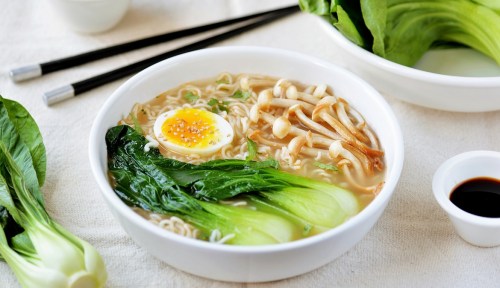How to Prepare Bok Choy to Enjoy All of Its Tasty, Gut-Healthy Benefits
Learn how to prepare bok choy for stir-frys, soups, and more with these tips for cutting and cooking the delicious Chinese vegetable.

Diversifying your diet is a surefire way to keep your health and wellness goals on track—including putting a ton of plant-based goodies onto your plate. ICYMI, the American Gut Project found that eating 30-plus plants per week is optimal for gut diversity. Instead of sticking to standard (and sometimes boring) salads and crudites, it’s worth mixing things up. For those looking for more healthy leafy greens, bok choy is definitely worth including in your rotation if it’s not there already.
Experts in This Article
New Jersey-based registered dietitian
Bok choy, aka Chinese cabbage, is a cruciferous veggie that’s been cultivated in China since the 5th century. Per the Food Literacy Center, bok (aka bai or pak) means white while choy (aka cai or choi) means vegetable. As a Brassica vegetable, it’s a member of the cabbage and mustard family alongside the likes of Brussels sprouts, cabbage, collard greens, kale, and broccoli. A veritable dream team of greens, if you ask me.
“Bok choy is an extremely healthy vegetable,” says Alyssa Smolen, MS, RDN, CDN, a New Jersey–based dietitian and content creator. “It contains vitamin E, vitamin C, and fiber.” It’s also rich in a host of micronutrients, including (but not limited to) vitamin A, vitamin K, calcium, and iron. Bok choy also contains powerful antioxidant plant compounds such as sulforaphane (an all-star for your gut, hormones, and liver). And beyond the health benefits, it’s also just straight-up delicious.
Ahead, we’re covering how to prepare bok choy with RD-approved preparation techniques and cooking ideas.
How do you prepare bok choy for eating?
1. Slice it
Start by cutting your bok choy lengthwise in quarters. (Baby bok choy, on the other hand, is small enough to accommodate being cut only in half.)
Depending on your recipe, you can then chop up your quartered bok choy into smaller pieces. This works well if you’re making a stir-fry or other kind of sauté dish with multiple vegetables that all need to cook simultaneously.
2. Trim the ends
“You can eat almost all the parts of bok choy,” says Smolen, including the crunchy white stalks and the leafy greens. However, she advises trimming off the edges, such as any browning or wilting leaves and the base.
3. Wash thoroughly
Cutting your bok choy and separating the stalks before washing them will help you rinse off any lingering dirt and residue, which Smolen says can easily get caught in all of the veggie’s nooks and crannies. (Should you choose to keep the stalks intact, just be sure to sufficiently rinse all the nooks and crannies.) Alternatively, you can also opt to plunge bok choy heads in a bowl of water to soak. No matter your cleaning method, make sure to pat them dry before cooking.
4. Decide how you want to cook it
According to Smolen, the most common ways to cook bok choy include sautéeing it or tossing it into a stir-fry. But you can also shred it with carrots and turn it into a versatile slaw, throw it into a healthy miso soup for extra greens and flavor, or try your hand at traditional Chinese dishes that use the ingredient like lo han jai.
Smolen suggests blanching your bok choy first to get the bitterness out of bok choy, particularly if you plan on sautéeing it. Simply heat up a pot of salted water until it boils, then drop in your cleaned, prepped bok choy into the pot and let it boil for about a minute. (It should turn bright green, not get dull.) Remove it from the pot then drop it into a bath of ice cold water to stop the cooking process.
“After blanching, individuals can heat a sauté pan with a neutral oil. Once hot, add bok choy,” Smolen says. You’ll know that it’s cooked once the bok choy is fork-tender and soft, though she says the cooking time is ultimately up to personal preference. “When the green is soft, add garlic and onions for a delicious flavor.”
If bok choy is still too bitter for your liking, Smolen advises cooking it for longer or balancing the flavor with an acid such as lemon.
5. Pair it
There are many bok choy cooking methods and even more recipes to choose from, but sautées and stir frys remain tried-and-true, crowd-pleasing cooking styles. Smolen suggests pairing your freshly prepared bok choy as a side dish with lean pork tenderloin and rice. Or, if you prefer a plant-based stir fry, her go-to includes bok choy with carrots, peppers, and tofu drizzled with a yummy sauce for veggies. Don’t forget: the more veggies are certainly the merrier, not only for your palate but also your gut and greater health.










